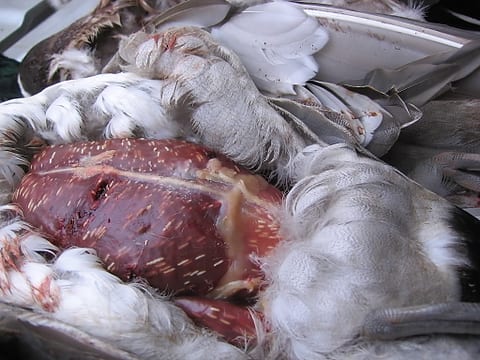 Its common name may sound like a delicacy, but rice breast is not considered appetizing by many hunters.
Its common name may sound like a delicacy, but rice breast is not considered appetizing by many hunters.
It’s a disease (sarcocystis) that strikes ducks, which ingest the eggs of the mature parasite in food or water. After hatching, the baby parasites migrate to the skeletal muscles and form cysts. The cysts resemble grains of rice and run in parallel lines throughout the muscle, usually the breast and thigh.
Dabbling ducks — such as the mallard, gadwall , widgeon and so forth — are most susceptible to rice breast.
“Duck species that feed in small, shallow waters are more likely to pick it up than, say, a bluebill that spends more of its time in big water,” said Scott Yaich, director of Conservation Operations at Ducks Unlimited.
Dabblers also take in a lot of water when feeding, sorting through it for the aquatic plants and the bugs they eat, likely increasing the odds of getting sarcocystis.
In contrast, divers hone in on a specific meal, such as clams or mussels.
A severe parasitic infection, though rare, can cause muscle loss in a duck and lead to weakness or lameness.
“It may reduce a bird’s physical condition,” said Tim Siegmund, regulatory biologist for the Texas Parks and Wildlife Department. “That could make it more apt to be harvested by a hunter or to be taken by a predator.”
In most cases, though, sarcocystis is asymptomatic.
“The birds don’t usually act sick from it,” said Dave Morrison, TPWD’s waterfowl program leader. “From what I know, it’s not fatal to birds. It’s a parasite. It occurs commonly. The birds with it are lying there fat, dumb and happy. As far as impacting the ability of birds to survive, it’s not a problem.”
Except to appetites.
“If my wife sees it, it’s gone,” Morrison said.
Morrison, though, has eaten his share of ducks with rice breast.
“And I’m still kicking,” he said. “You may skin the duck and see it and go, ‘Ah, that’s disgusting. I’m not going to eat this.’ But if cooked properly, it’s not going to hurt anyone.”
Siegmund added that a bird’s infection “doesn’t affect the taste.”
People handling a duck infected with sarcocystis need not worry about catching anything, experts told Lone Star Outdoor News. You probably don’t want to toss the infected duck to your dog, though, as it can live within the animal’s digestive tract.
While eating the duck wouldn’t pose a serious health threat, it does risk continuing the parasite’s life cycle and infecting other animals.
Yaich said he can “block it out” if a duck has only a few cysts and enjoy a meal. Seeing a bunch of them, though, makes him lose his appetite, he admits.
He’s not alone.
Many hunters in the field chunk ducks infected with sarcocystis, Morrison said. That can be a problem.
“I would strongly urge people to take the bird home and do what you need to do there,” Morrison said. “If a game warden sees you, it’s a sure way of going home with a piece of paper.”
Game Warden Jennifer Kemp said the action qualifies as a waste of game.
“The disease is not considered hazardous to humans,” Lt. Kemp said. “Throwing it out would be considered waste of game. If parts of it are not edible, you may dispose of those. However, whatever part is edible, you have to keep.”
Kemp said shooting a diseased bird also counts against your daily bag limit.
“Whatever you kill counts against your bag limit, whether the bird is infected or not,” she said. “That has no bearing. You’re taking the bird out of the population, so it counts against your bag limit.”

